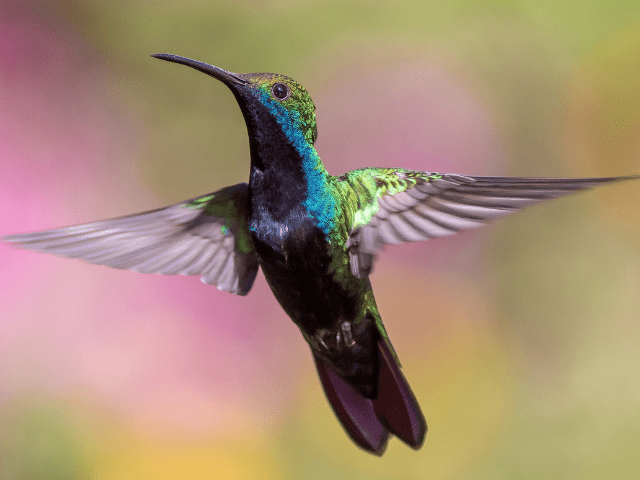Hummingbirds are tiny, captivating, and vibrant birds. As a bird lover, do you ever wonder if you'd see some of these hummingbirds in Texas?
It would be nice to know if these eye-catching birds migrate to this part of the country.
Chances are, you might find more of them in some regions of the state than in others.
So...
Let's try and discover more about what makes the different types of hummingbirds fascinating. Who knows? Maybe you'll come across them one day. After all, it's pretty natural for some of us to admire such beauty.
Hummingbird Species You Can Find in Texas
1. Ruby-Throated Hummingbirds
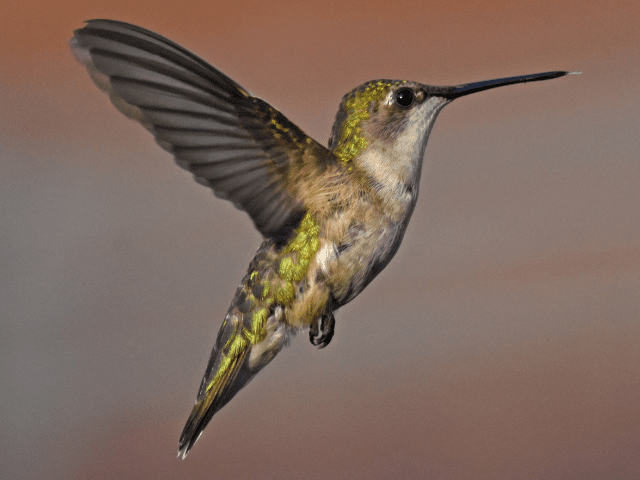
This bird is a relatively small creature compared to the other hummingbirds you typically encounter in East Texas. They only weigh about 0.1-0.2 oz (2-6 g), are 7-9 cm long, and have a wingspan between 8-11 cm.
A female species has a green-colored back with a white belly, while the male hummingbirds have a ruby-red neck that makes it easier to recognize them.
They are also famous for being native breeders because they go to East Texas as their primary breeding territory. You will most likely find hummingbirds in Texas near sea level to 700m.
You can easily attract these hummingbirds by putting out nectar feeders.
You can also have a tubular plant in your garden or a cardinal flower.
2. Rufous Hummingbird
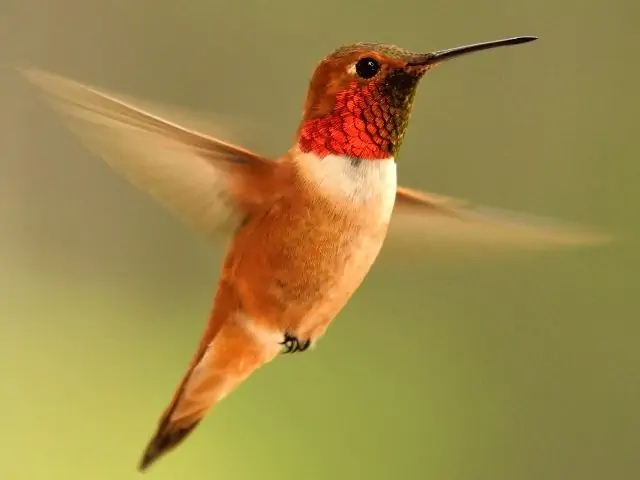
A rufous hummingbird has the average size of most of its kind. They weigh 0.1-0.2 oz (2-5 g) and have lengths between 7-9 cm and a wingspan of 11 cm.
A male rufous hummingbird has an orange shade, a white breast, and a combination of reddish-orange around its chin. On the other hand, females have a greenish-brown shade at their backs, with white breasts and bellies.
A rufous hummingbird is the longest to migrate of all the species due to its size. They travel about 4000 miles and mate with several partners in a season. Although you'd often see them in spring, it might surprise you how they also stay in winter to settle for a more inactive lifestyle.
3. Calliope Hummingbird
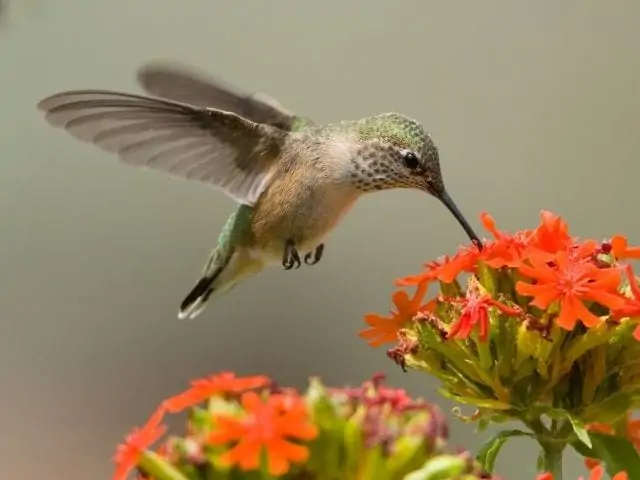
Calliope hummingbirds are the smallest of their kind. They weigh 0.071-0.106 oz (2-3 g), have lengths of 4”, and a wingspan of 10.5-11 cm.
You will never have a hard time distinguishing a Calliope hummingbird. A male calliope has very bright magenta throats, unlike females with small spots on their throats. Both hummingbirds have a glossy greenback.
However, it might be pretty challenging if you're expecting a Calliope hummingbird to visit your garden. If you like these hummingbirds to stop by your garden, try setting up a hummingbird feeder, having a plant in your yard, and adding tubular flowers.
Fun Fact: This particular species is also one of many Minnesota hummingbirds and hummingbirds in Ohio to watch, making this bird a common sight in both these states, respectively.
4. Black-Chinned Hummingbird
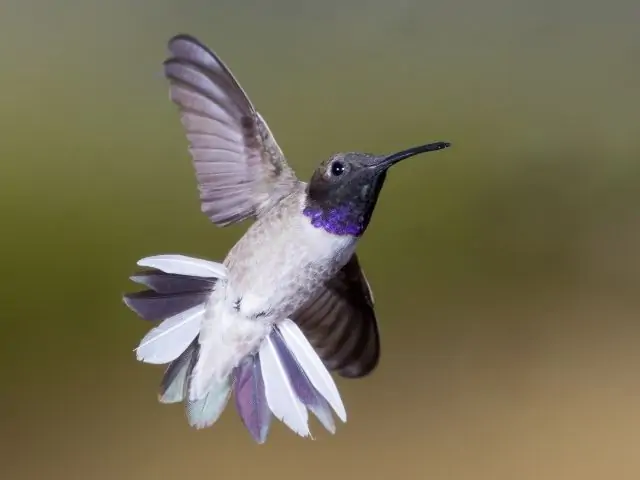
A black-chinned hummingbird is a bird quite similar to the ruby-throated hummingbird. It only weighs about 0.1-0.2 oz (2.3-4.9 g), is 9 cm long, and has a wingspan of 11 cm.
Both men and women hummingbirds have metallic grayish-green colored backs, and their necks and breasts are light grayish to pale white.
You can find this bird variety on the west side of Texas during their breeding season in the summer months.
Just like the other hummingbirds, you can attract them by setting up a hummingbird feeder with nectar. Maybe you can also try having some tubular plants, coral honeysuckle, or a trumpet creeper in your garden.
5. Costa’s Hummingbird
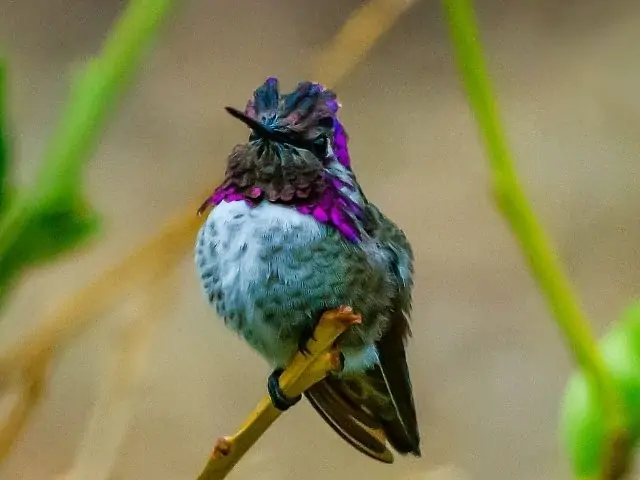
A Costa’s hummingbird is 3-3.5 inches long and weighs 2-3 grams, slightly smaller than the other hummingbird species.
Just like the Calliope Hummingbird, the male Costa’s Hummingbird has a reddish-purple head and gorget with long streaming throat feathers and a shade of metallic green on its back.
While on the other hand, the female Costa’s hummingbird has a grayish-green back; she has black spotting on her neck and a dark tail.
If you want to attract a Costa Hummingbird, you should invest in a hummingbird feeder and fill it with a sugar-water mixture. But please do so without any food coloring. You can probably maintain a flower garden too.
6. Lucifer Hummingbird
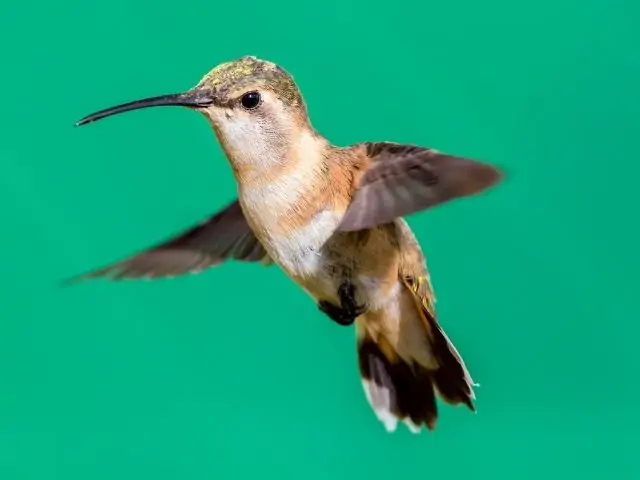
The Lucifer Hummingbird is among the Texas hummingbirds that are a professional in the Chihuahuan desert. You can effortlessly distinguish this type of hummingbird with its long, arched bill and a pretty large head. Although, many confuse it with a male costa's hummingbird.
The male bird is noticeable with greyish green plumes all over its body with a purple neck and a green crown.
It has a slightly brownish neck with its back and its crown in green.
A Lucifer hummingbird is a typical inhabitant of Central Mexico to the big bend part of South Texas. You will likely locate this bird breeding in the open desert or on the slopes of Chisothe s Mountains.
But when in Mexico, the Lucifer hummingbird mostly stays in dry areas with brushy vegetation or scattered trees. Dry oaks and pine-oak woodland within the rocky canyons also attract this bird. It likes feeding on flowering agaves and small insects too.
7. Buff Bellied Hummingbird
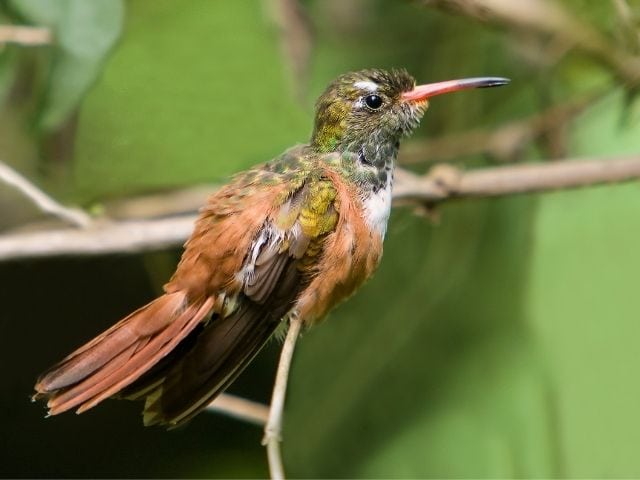
Buff Bellied Hummingbird is a medium-sized bird of its species. It weighs around 2-4 grams, and the bird's length ranges from 3.9-4.3 inches.
Both males and females are greyish-green in color with long red, bright beaks. The only difference they have is that most female hummingbirds have duller shades.
Unlike the other hummingbirds, call yourself lucky if you have a Buff-bellied hummingbird visit you. Cross your fingers, and try putting some hummingbird feeders in your garden. In some cases, they can even pay you a visit in winter.
8. Allen's Hummingbird
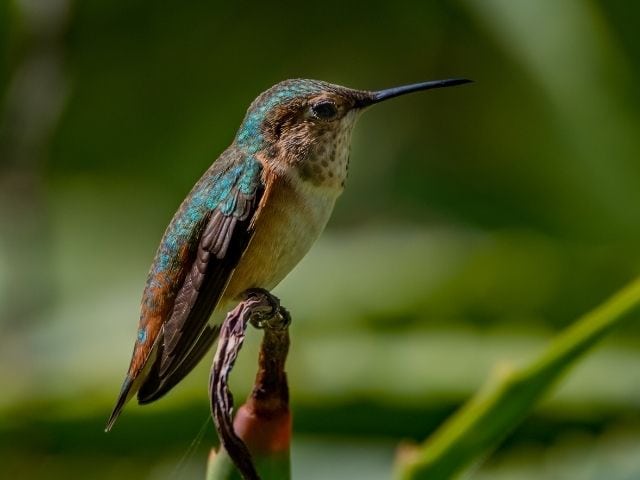
An Allen’s hummingbird is a rare kind. Although they look a little similar to the Rufous hummingbird, the difference is that Allen’s possess greenbacks while Rufous’ have coppery-orangey color.
They have the average size of a hummingbird, around 2-4 grams, are 9cm long, and have a wingspan of 11cm.
Since they are a rare species, you might only see them during winter while they are migrating. The best chance to see them visit you is by placing a hummingbird feeder and changing the water once in a while to obtain freshness.
9. Anna's Hummingbird
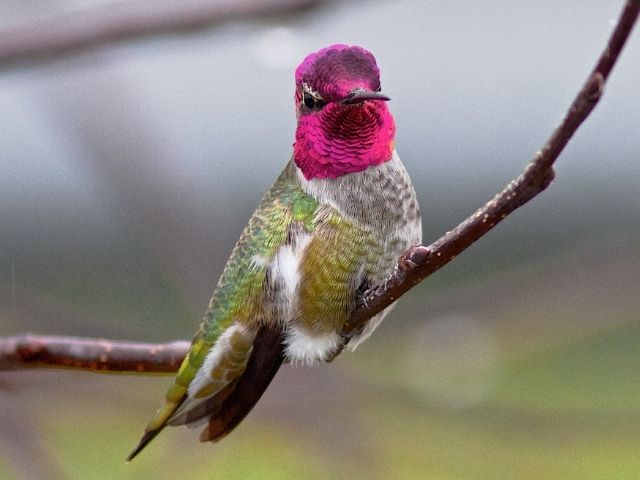
Anna’s hummingbird is a unique species you can commonly find around Central Texas. They are similar to the Allen's; they are frequent visitors during the winter season.
These birds are slightly larger than the ruby-throated hummingbirds, also known as Archilochus colubris. Many would refer to them as medium-sized hummingbirds. They weigh 3-6 grams, are 10cm long, and with a wingspan of 12cm.
Most of the Anna’s are gray or green. The male’s throat stands out because of its beautiful iridescent violet-pinkish gorget and crown. Again, females are usually not as vibrant but have a white line on their eyes that makes them distinctive.
Having a suitable hummingbird feeder early in spring gives you more chances of undoubtedly attracting these birds to your garden. You can even have some of them stay during winter if you shelter them and keep your nectar feeder full.
Fun Fact: Aside from being a "royalty" bird, this species is also one of the popular hummingbirds in Illinois!
10. Rivoli's Hummingbird
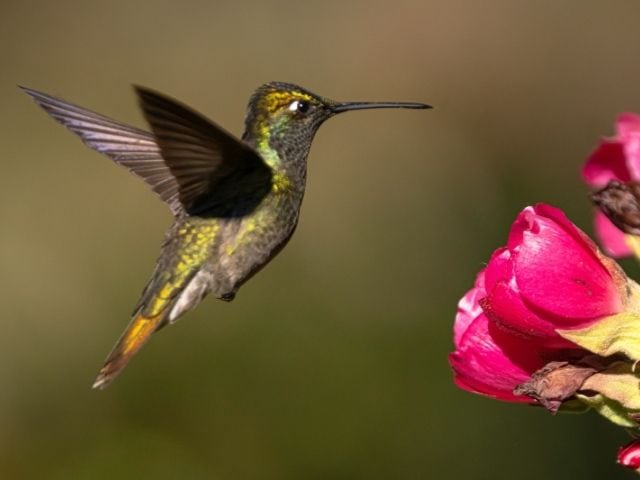
Rivoli’s hummingbirds are also known as magnificent hummingbirds. Its name came from Francois Victor Massena, the Duke of Rivoli.
One can consider them large-sized birds, weighing 7-8 grams, 11-14 cm long. They hold the highest heart rate record for any living vertebrae ranging from 420-1,200 beats per minute.
Rivoli’s have darker colored backs, men have shiny green throats and black chests. For females, their breasts have gray colors and duller colors than the male Rivoli.
You have to place sugar water feeders without food coloring in your garden if you wish to attract a Rivoli’s hummingbird.
11. Violet Crowned Hummingbird
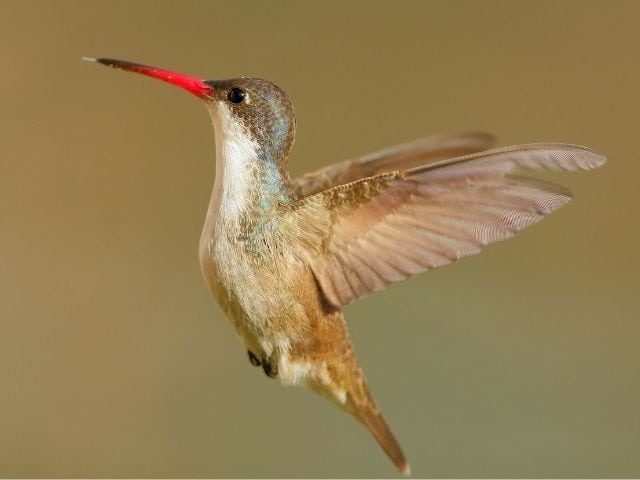
Violet Crowned Hummingbirds are rare birds of their kind. They belong to medium-sized hummingbirds, weighing about 5 grams and are 10cm long.
They have a dark green shade on their backs, white underparts, and a violet crown that makes them distinguishable. The female is less colorful than the male, but they have metallic bluish-green tails.
12. Berylline Hummingbird
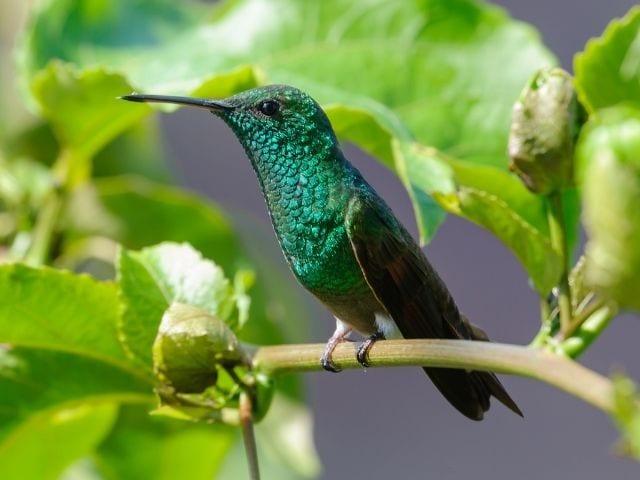
Berylline is one type of native hummingbird. Its name came from the Latin word “beryllina,” which means green color.
They are medium-sized birds, with lengths ranging from 1.-1.9 inches.
Berylline do have shimmering green feathers; their tail feathers have a shiny purplish color. Unlike the other hummingbirds, both males and females look the same.
13. White Eared Hummingbird
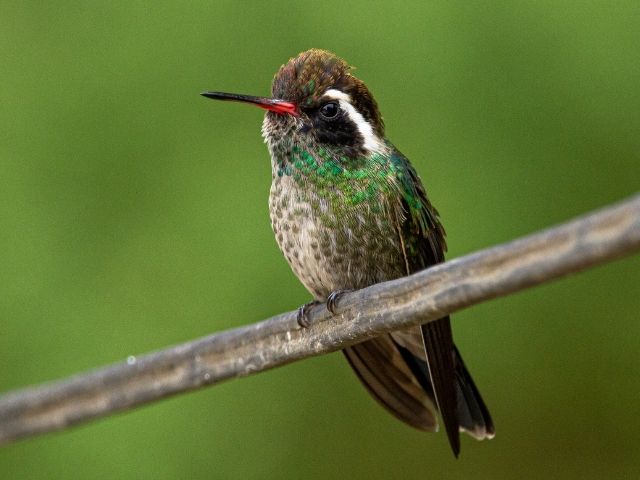
White Eared Hummingbirds are pretty unusual with a white ear stripe hence the name. This bird features striking, brilliant colors like a broad billed hummingbird.
For males, the back and chest are green, and they have a long thin straight red bill with black on the top. Their necks also have a hint of blueish green. For females, their throats are cream-colored and have a deep green crown.
You will rarely see these birds in the canyons and mountains in the northern part of Mexico. They are migratory birds breeding from March to April, then leaving for the hills in Mexico during winter.
14. Violet Crowned Hummingbird
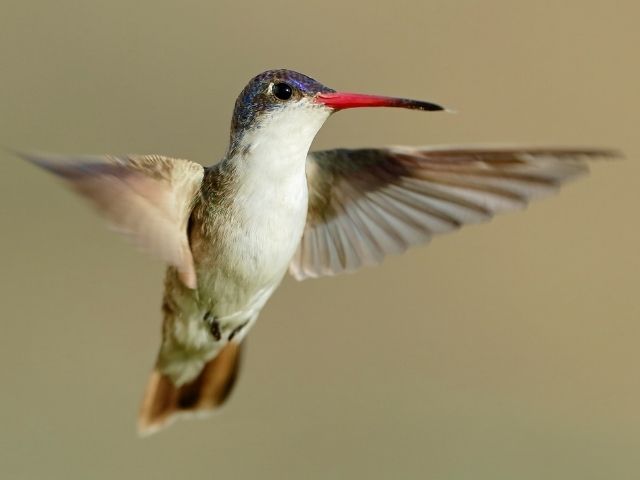
The violet-crowned hummingbirds are also a rare kind. They are easily known because of their white under plumage, have dark brown backs, and iridescent bluish-violet crowns, which is how they got their name.
Females almost share the same look, but as usual, they have paler shades than men. You will typically encounter them in the Davis mountains.
You have greater chances of encountering this bird in southeastern Arizona's wooded parks, gardens, and canyons to southwestern New Mexico. In winter, you will see these violet crowned hummingbirds drinking from sap holes since there is no flower available during such season.
They prefer to feed on a flower. Some of the flowers they like are agave, sage, penstemon, and paintbrush.
15. Broad Tailed Hummingbird
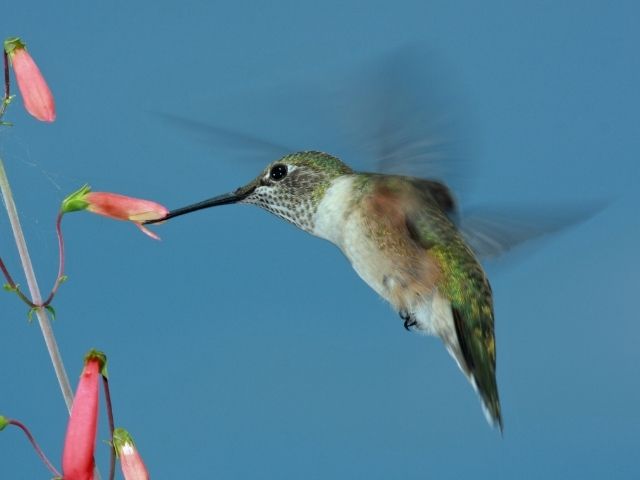
Many people believe that a broad-tailed hummingbird could be closely related to the ruby-throated hummingbird. That's not even surprising since several hybrids might have occurred in the wild. You also have better chances of attracting this hummingbird to your backyard.
If that's what you intend to do, you only need to ensure creating a natural environment for them. That entails giving whatever the birds need to survive, like having some native plants, a flower, or a hummingbird bush as their food source.
Furthermore, this bird is a frequent inhabitant of the Rocky Mountains. But some of these hummingbirds are migratory during the breeding season.
It won't even be hard identifying this from the other hummingbirds. Males have magenta-colored necks, bluish-green underparts, and a green head. On the contrary, you will notice how females have dark spots on their throats and white undersides.
Frequently Asked Questions
What time of the year does Texas hummingbird migration happen?
You’ll start seeing hummingbirds migrate to their breeding grounds around January until mid-May during the spring migration. On the contrary, fall migration generally lasts from July until August or September.
The only species breeding in Texas is the black chinned hummingbird. Relatively, you can mostly encounter a ruby throated hummingbird in east Texas from springtime into early April. Generally, hummingbirds migrate 1,500 miles from Texas to Mexico and Central America.
Abundance graphs of ruby-throated hummingbirds will be an excellent way to show you their movement patterns. Their kind mostly leaves in winter from July to mid-November, and they have noticeable abundance through the breeding range.
Several migrating hummingbirds love spending the winter somewhere further in the South, crossing Texas's borders or in Mexico. However, there are sightings of these birds in San Antonio during winter, so you might as well keep your nectar feeder fresh at all times.
Learn more about Hummingbird migration in Kentucky in this video:
When should you stop feeding hummingbirds in Texas?
When to stop putting food in a hummingbird feeder mainly depends on its kind. Occasionally, they appear in the area earlier than expected. Several other factors are also at play when putting a halt to feeding these hummingbirds.
Aside from the species, other factors include location, climate, and migration. If you want to put up a hummingbird feeder in Houston and Austin, the best time is March to October. While in San Antonio, you can place a feeder between March and November.
Additionally, you can set up a feeder in McAllen year-long since the type of hummingbirds in that area are year-round residents. In El Paso, you can hang your feeder from April to October, and the same thing goes for Lubbock too.
Once you stop seeing birds around the area for seven to ten days, you can start removing the feeders and putting them back next spring. It might even surprise you to see a buff-bellied hummingbird sharing its feeding territory with an acorn woodpecker.
How long do hummingbirds stay in Texas?
The length of a hummingbird's stay in Texas is dependent on their kind because some stay all year while you'll only see the rest during the migration period. Of all the hummingbirds in Texas, the one you would most likely see often is the ruby-throated hummingbird. It's that pretty bird with golden-green feathers and an eye-catching red-colored neck.
The Big Bend National Park and the Davis Mountains are some of the best places where you can encounter even the rarest hummingbird species. You might even chance upon the blue-throated or the broad billed hummingbird straying in the Big Bend National Park.
Final Thoughts
Texas has a wide variety of bird species than other states, which is why it quickly became any birdwatcher's favorite spot. The Big Bend National Park is an excellent place to go if you want to see more of these creatures.
Now we have more profound ideas of their habitat, diet, behavior, what plant could attract them, and what can lead them to a hummingbird feeder. They may appear belligerent at times, but their distinct characteristics make these hummingbirds an excellent addition to the birding world.
Maybe you now consider attracting these birds with strikingly iridescent plumages to your yard. If so, that's hardly surprising given the birds' extraordinary appeal. But at least now you know just how to make your garden a welcoming home for them.

